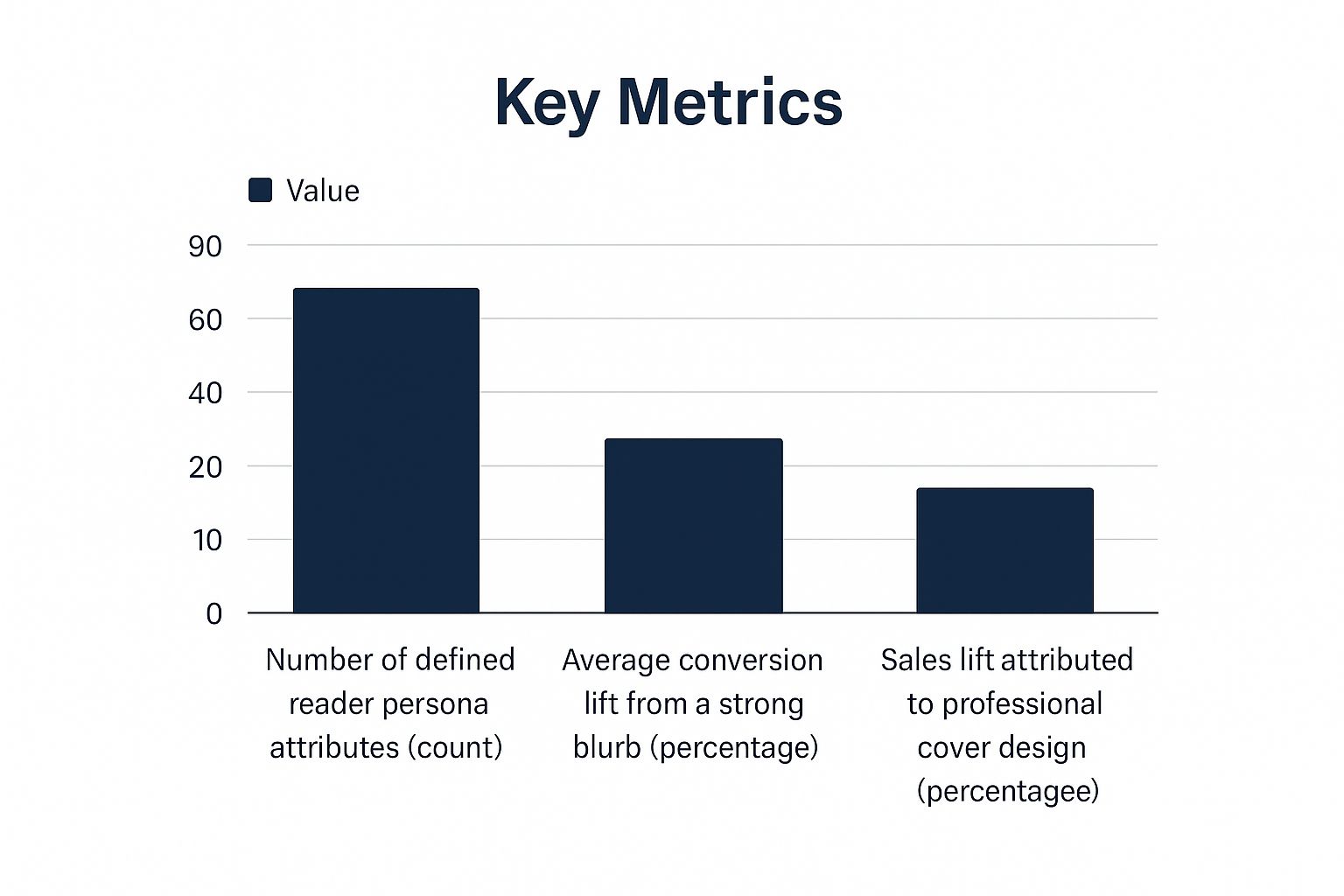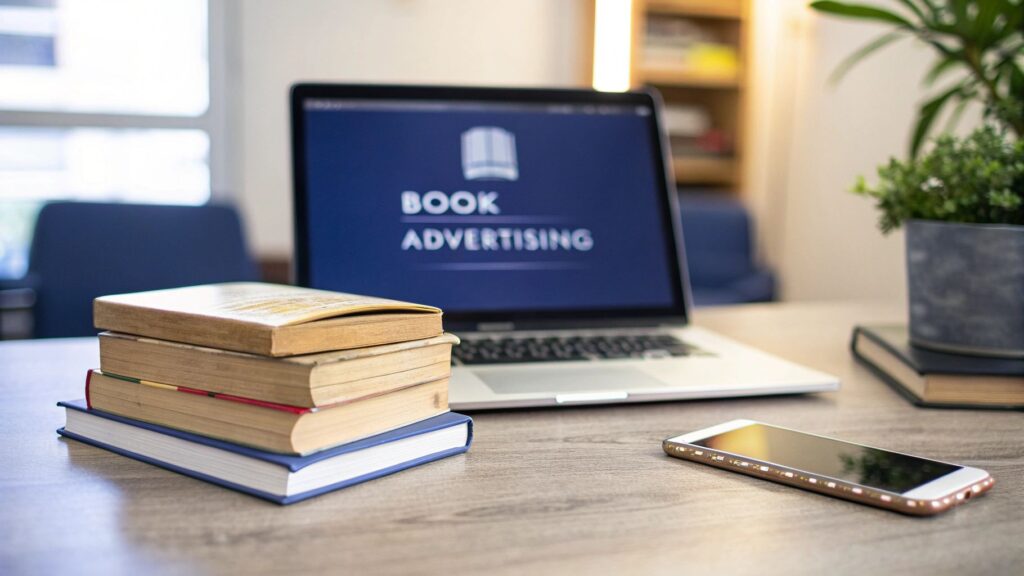Before you even think about spending a single dime on ads, you need to get your house in order. Seriously. I’ve seen too many authors throw money at Facebook ads, thinking it's a magic bullet, only to see it all vanish with nothing to show for it. Why? Because they skipped the foundational work.
Successful book advertising isn't about the ads themselves; it's about what you're advertising. Pouring money into promoting a book with a weak foundation is like trying to sell a house with a leaky roof and a cracked foundation. You might get a few people to look, but nobody's buying.
Building Your Foundation Before You Spend a Dime
Let's talk about the three absolute non-negotiables. These are the pillars that will support your entire advertising strategy and, frankly, your book's long-term success. Get these right, and you’re giving your book a real fighting chance.
- Who is your ideal reader? And I mean, really who are they?
- Does your book blurb actually sell? This is your 24/7 salesperson.
- Is your cover professional? In a sea of books, your cover is your lifeline.
Define Your Ideal Reader
You can’t market a book to "everyone who likes to read." That’s a recipe for disaster. You'll end up with generic ad copy that speaks to no one and a budget that drains faster than a leaky bucket.
You need to create a reader persona—a detailed profile of the one person who would absolutely devour your book. Get specific. How old are they? What do they do for a living? What TV shows are they obsessed with? Which authors are already on their bookshelf? Are they scrolling through TikTok or arguing in a Goodreads forum?
The more you know about this person, the easier it becomes to find them online and craft an ad that feels like it was written just for them. This single exercise will guide every marketing choice you make from here on out.
Craft a Blurb That Sells
Your book description is pure sales copy. Its one and only job is to grab a potential reader by the collar and make them need to know what happens next.
A great blurb opens with a hook, introduces the core conflict (or the central promise, for non-fiction), and ends on a note of high tension. It's not a summary; it's a teaser.
A huge mistake I see authors make is trying to tell the whole story in the blurb. Don't do it. Your goal is to evoke emotion and spark curiosity. For a thriller, ask a question that sends a shiver down their spine. For a romance, hint at the impossible obstacle keeping the main characters apart. This is a critical piece of your book marketing plan, so take the time to get it right.
This chart breaks down just how much of an impact these foundational elements have.

As you can see, a professional cover provides the biggest lift by far. It’s not just important; it’s everything.
Invest in a Professional Cover
Please, do not skimp on your cover design. In the endless scroll of an online bookstore, your cover is the only thing that will make someone stop. It has about two seconds to do its job.
An amateur cover immediately signals an amateur book, fair or not. It kills a sale before a reader ever gets to your brilliant blurb or the first page of your story.
A professional designer understands the visual language of your genre. They know the fonts, colors, and imagery that instantly signal "epic fantasy" or "gripping psychological thriller" to the right readers. This isn't an expense; it's the single best marketing investment you can make. A killer cover gives your book instant credibility and makes it look like it belongs right next to the bestsellers.
Choosing the Right Advertising Platforms for Your Book

Once you’ve got your book's foundation in place, the million-dollar question becomes: where should you actually spend your ad budget? It’s tempting to try a little bit of everything, but that’s a fast track to draining your funds with nothing to show for it. Smart book advertising is all about meeting readers where they already hang out.
The platform you pick dictates who sees your book, what advertising tools you can use, and, most importantly, your return on investment. Let's dig into the heavy hitters for authors and figure out where your book will feel most at home.
The King of Conversion: Amazon Ads
When it comes to pure sales, nothing beats Amazon Ads. It's the undisputed champion for one simple reason: purchase intent. People browsing Amazon aren't just killing time; they're actively looking to buy something. This makes it an incredibly powerful platform for driving direct sales of your book.
With Amazon Ads, you can strategically place your book right in front of readers who are searching for similar authors or browsing your specific genre. The targeting is surgical. You can bid on keywords like "psychological thriller" or even target the product pages of specific authors in your niche.
Think of it this way: if a reader is on Amazon looking at a Stephen King novel, placing your new horror book right beside it is the digital equivalent of prime shelf space in a real-world bookstore. You’re catching them at the perfect moment of decision.
Building Your Brand with Facebook and Instagram Ads
While Amazon is for closing the deal, Meta's platforms—Facebook and Instagram—are where you build relationships. Here, the game is a little different. You're not just pushing for a one-time sale; you're building an author brand and cultivating a community of fans.
The real magic of platforms like Facebook Ads is their incredibly deep demographic and interest-based targeting. You can zero in on users based on:
- Interests: Readers who follow specific authors, genres, or book-related pages.
- Behaviors: People who have previously clicked on book ads or engaged with literary content.
- Demographics: Fine-tune your audience by age, location, gender, and more.
Let's say you've written a historical romance set in Regency England. You could build a campaign targeting women aged 25-55 who have shown an interest in Jane Austen, the show Bridgerton, and other historical fiction pages. This kind of precision lets you craft a message that truly speaks to a niche audience, making them far more likely to follow your author page and, eventually, buy your book.
Running ads on Facebook and Instagram is a long game. It's about introducing yourself to new readers, getting them to join your mailing list, and nurturing them until they become loyal fans. A successful campaign here builds an audience for your entire career, not just one book.
The Power of a BookBub Featured Deal
A BookBub Featured Deal isn't your typical ad platform. It's more of a high-impact, one-time promotional event. For authors with a discounted or free ebook, landing a Featured Deal can be a genuine game-changer, driving a massive spike in sales and visibility almost overnight.
BookBub is essentially a curated email newsletter that sends daily deals to millions of ravenous readers who have signed up for alerts in their favorite genres. Getting selected is tough, no doubt, but the results can be staggering. A single promotion can push thousands of sales in a day, often launching a book straight up the bestseller charts.
This isn't a tool for day-to-day campaign management but a strategic weapon for a book launch or to breathe new life into an older title. The audience is highly engaged and trusts BookBub’s recommendations, which is why conversion rates are so high. It’s an essential piece of the puzzle if you’re trying to figure out how to advertise a book for mass exposure.
Book Advertising Platform Comparison
Choosing where to spend your money can be tough, as each platform serves a different strategic purpose. This table breaks down the main players to help you decide which one aligns with your immediate goals.
| Platform | Best For | Audience Type | Typical Cost Per Click (CPC) | Key Advantage |
|---|---|---|---|---|
| Amazon Ads | Direct sales, reaching readers at the point of purchase | High-intent buyers actively shopping for books | $0.25 – $1.00 | Purchase Intent: Users are on the site to buy. |
| Facebook/Instagram Ads | Brand building, growing an email list, community engagement | Passive scrollers, genre fans, lookalike audiences | $0.50 – $2.50 | Granular Targeting: Unmatched interest and demographic data. |
| BookBub Featured Deals | Massive visibility spikes, hitting bestseller lists, reviving backlist titles | Engaged deal-seekers, avid genre readers | N/A (Flat fee based on genre/price) | Massive Reach: Access to millions of curated, eager readers. |
| Google Ads | Capturing search intent, driving traffic to an author website | Readers actively searching for specific books, authors, or topics | $0.50 – $2.00 | Search Intent: Targets users looking for specific information. |
Ultimately, the best platform—or combination of platforms—comes down to your goals. Are you focused on immediate sales, long-term brand building, or a huge visibility boost? Answering that question is the first step in creating a strategy that ensures every dollar you spend is working hard to connect your book with the right readers.
Creating Ad Campaigns That Actually Convert

Anyone can launch an ad in a few clicks. The real challenge—where the art and science of marketing truly collide—is creating an ad that consistently sells books. A great campaign isn't just a nice-looking image with a "buy now" link. It’s a well-oiled machine built to turn a casual scroller into your next avid reader.
The secret lies in getting three things to work together in perfect harmony: irresistible copy, scroll-stopping visuals, and laser-focused targeting. When these elements click, your ad doesn't feel like an ad at all. It feels like a personal, urgent recommendation made just for them.
Writing Ad Copy That Hooks Readers
Your ad copy has one job: make someone stop what they're doing and pay attention. You only have a couple of seconds, so that first line—the hook—is everything. The best ones are always tuned into the specific emotions and tropes of your genre.
For a thriller, you could open with a chilling, unanswered question: "What if the person you trust most is the one you should fear?" It’s an instant shot of suspense and intrigue.
On the flip side, a romance ad needs to pull at the heartstrings. A hook like, "They were archenemies by day, but their anonymous letters told a different story," immediately signals a beloved trope (enemies-to-lovers) and promises that delicious emotional conflict. Your goal is always to tap into the core promise of your genre.
Your ad copy should sound like a whispered recommendation from a trusted friend, not a sales pitch from a corporation. Use language that your target readers use, reference tropes they love, and always focus on the emotional journey your book offers.
To make sure your campaigns deliver real results, getting a handle on understanding performance marketing is a game-changer. It shifts your focus from just spending money to investing in actions that directly lead to sales.
Designing Visuals That Stop the Scroll
On a crowded social media feed, your ad's image is your first line of defense against being ignored. A generic stock photo simply won't do. You need something bold and professional that screams your book's genre and vibe from the moment someone sees it.
Here are a few visual strategies that I’ve seen work wonders for authors:
- The 3D Mockup: Displaying your cover as a tangible 3D object—even for an ebook—makes it feel more real and valuable. Go a step further and place it in a setting that matches the book's atmosphere, like on a cozy blanket for a romance or in a dark, misty forest for a fantasy.
- Quote Graphics: Pull a powerful, punchy line from a five-star review or the book itself and overlay it on a compelling background. A rave review from a well-known blogger or a gripping line of dialogue can be incredibly persuasive.
- Character Art: This is gold for fantasy and sci-fi. If you have compelling characters, commissioning some art can forge a powerful, immediate connection with readers who are drawn to strong protagonists.
No matter which route you take, the key is clarity and impact. Make sure the book cover is clearly visible and that any text is big and easy to read on a small phone screen.
Mastering Laser-Focused Audience Targeting
You could craft the world's most perfect ad, but if you show it to the wrong people, it will absolutely flop. This is where the true power of platforms like Facebook and Amazon Ads really shines. The reader persona you built earlier? That’s your targeting blueprint.
Don’t just aim for a broad category like "people who read." Get granular. For instance, if you've written a gritty space opera, you could target users who have shown interest in:
- Comparable Authors: Fans of authors like James S.A. Corey or Ann Leckie.
- Similar Media: People who like TV shows such as The Expanse or Battlestar Galactica.
- Specific Interests: Pages and groups dedicated to science fiction, space exploration, or military sci-fi.
This is especially powerful on Amazon, where you can literally target readers who have recently looked at or bought books almost identical to yours. For a detailed guide on this, our post on Amazon advertising for books breaks down the exact steps.
By narrowing your focus this way, you ensure your ad budget is spent on the people most likely to actually buy your book, which dramatically increases your chances of turning clicks into sales.
Catching the Digital Wave: How Readers Find Books Now
The way readers stumble upon their next favorite book has completely changed. Not too long ago, it was all about prime bookstore placement and getting a nod from traditional reviewers. Today? A single viral video or a shout-out from a trusted online creator can launch an unknown author onto the bestseller lists, seemingly overnight. This isn't just a "nice-to-have" strategy anymore; tapping into these digital currents is crucial for advertising a book in today's world.
And the numbers don't lie. The shift to digital is massive. Global online book sales are on track to hit $26.04 billion in 2025, a figure that has almost doubled since 2019 and is expected to balloon to $48.27 billion by 2034. This explosive growth is fueled by social media and authors connecting directly with their readers, cutting out the old gatekeepers. Just look at the UK, where science fiction and fantasy sales recently shot up an incredible 41.3% in a single year, mostly thanks to the buzz generated on TikTok. You can find more insights on this shift in book sales statistics.
Riding the BookTok and Bookstagram Wave
You can't talk about modern book marketing without mentioning #BookTok and #Bookstagram. These aren't just hashtags; they're massive, reader-led communities that can create incredible organic buzz for a book. The real power here is authenticity. A creator genuinely crying on camera after finishing your novel is a thousand times more convincing than any ad copy you could ever write.
You don't need a huge following to get in on the action, either. The goal is simply to get your book in front of the creators who already have an audience.
- Make your content shareable. Think short videos with gripping quotes, aesthetic mood boards for your characters, or even just a quick behind-the-scenes look at your writing space.
- Be part of the community. Don't just drop links and run. Follow creators in your genre, leave thoughtful comments on their posts, and actually join the conversation. People can spot a marketer a mile away.
- Spark some user-generated content. A simple contest can work wonders. Ask readers to post a picture of your book in a cool location or to film their reaction to that big plot twist.
Working with Book Influencers
While organic buzz is amazing, a well-planned partnership with a book influencer can give you a serious, targeted boost. These creators are the new tastemakers, and their followers genuinely trust their recommendations.
The key is finding the right fit. Don't just chase big numbers. A micro-influencer with 5,000 super-engaged fantasy readers is infinitely more valuable for your epic fantasy novel than a generic lifestyle influencer with 100,000 followers who don't care about dragons.
When you reach out, make it personal. Mention a specific review they did that you loved and explain why you think your book is a perfect match for their audience. The standard, respectful approach is to offer a free advance reader copy (ARC) with absolutely no strings attached.
Don't Forget Your Formats: An All-of-the-Above Strategy
Today's readers are everywhere, and they consume stories in all sorts of ways. If you're only promoting your print book, you're leaving a huge chunk of the market on the table. A truly effective strategy needs to embrace every format you have available.
So many authors treat their audiobook and ebook versions like an afterthought. That’s a huge mistake. The audiobook market is absolutely booming, and a growing number of readers are "audio-first." Your advertising needs to speak directly to them, maybe by highlighting the narrator's incredible performance or the immersive sound design.
You'll want to tailor your campaigns to each format specifically.
- Ebook Ads: These are perfect for impulse buys. Use sharp calls-to-action like "Read Now for $2.99" and target readers on deal sites like BookBub.
- Print Book Ads: This is where you lean into the visuals. Use gorgeous 3D mockups or create fun "unboxing" style videos that show off the physical beauty of your book. Make it feel like a collector's item.
- Audiobook Ads: Use the audio itself! A 30-second clip of a tense, dramatic scene read by a talented narrator can be an incredibly powerful hook to get people listening.
By meeting readers where they are, in the format they love most, you build a constant, relevant presence that keeps your book at the top of their minds.
Using Data and Technology to Optimize Your Ad Spend
https://www.youtube.com/embed/eg4I-RU_vKU
Pouring money into an ad campaign without tracking the results is a shot in the dark. It’s like sailing without a compass—you’re moving, but you have no idea if you’re getting closer to your destination or just heading further out to sea.
The great thing is, you don’t need a degree in data science to make smart, profitable decisions anymore. Modern ad dashboards are packed with information. The real trick is knowing which numbers matter and what they’re trying to tell you about your readers.
Decoding Your Ad Dashboard
Opening your Amazon or Facebook Ads dashboard for the first time can feel like trying to read a foreign language. There are dozens of metrics, and it's easy to get overwhelmed. My advice? Ignore most of them, at least for now.
Just focus on the handful of Key Performance Indicators (KPIs) that tell the most important part of your story:
- Impressions: This is simply how many times your ad was shown on a screen. It’s a measure of reach, but it doesn't mean anyone actually noticed it.
- Click-Through Rate (CTR): The percentage of people who saw your ad and actually clicked on it. If your CTR is low, it’s a strong signal that your image or headline isn’t grabbing enough attention to stop the scroll.
- Cost Per Click (CPC): This tells you what you're paying every time someone clicks. The goal is to get this number as low as possible without sacrificing the quality of your audience.
- Conversion Rate: This is the big one. It's the percentage of people who clicked your ad and then followed through to buy your book. A high CTR with a low conversion rate means something is wrong on your book's sales page.
Getting a handle on these numbers is your first step. You can dive much deeper into how to track book sales data to directly connect your ad spend to your royalties. That’s where the magic really happens.
The Power of A/B Testing
Once you have a feel for how your ads are performing, it’s time to start making them better. This is where A/B testing, or split testing, becomes your best friend. The idea is wonderfully simple: you run two nearly identical ads, changing just one thing between them to see which version performs better.
I see authors make this mistake all the time: they change the headline, the image, and the targeting all at once. When the results come in, they have no idea which change made the difference. Always test one variable at a time for clean, reliable data.
So, what should you test first? Start with the elements that will have the biggest impact.
- Headlines: Try a question-based hook against a bold statement.
- Ad Creative: Test a 3D mockup of your book cover against a simple graphic with a powerful review quote.
- Audience: Run the exact same ad to two different groups, like fans of Stephen King versus fans of Dean Koontz.
This methodical process takes the guesswork out of advertising. Instead of relying on gut feelings, you’re making decisions based on what your audience actually clicks on.
Tying It All Together with Technology
Trying to manually track every click from every ad on every platform is a recipe for a headache. Thankfully, some incredible technology can do the heavy lifting for us.
For any author advertising outside of Amazon, mastering Amazon Attribution is a non-negotiable tool. It allows you to create special tracking links that show you precisely which Facebook ad, blog post, or email blast led to a sale on Amazon.
This data is gold. It might reveal that your Instagram ads get tons of clicks, but your email newsletter links are what actually convert into sales. With that insight, you can confidently shift your budget away from what looks good and into what actually works.
This is just one piece of a rapidly growing ecosystem. The global book marketing software market is projected to hit $144.3 billion in 2025 and is expected to climb to $248.8 billion by 2035. These platforms are designed to help authors create hyper-targeted campaigns by combining data with great storytelling, ensuring your book finds the right readers—not just the biggest audience.
How to Match Your Advertising to Genre and Format Trends

Throwing a generic ad out into the world and hoping it sticks is a surefire way to waste your budget. Your readers are sophisticated; they have finely tuned expectations for their favorite genres, and your ad needs to speak their language from the first glance.
An ad for a hardboiled detective novel should feel gritty and tense. One for a contemporary romance? It has to radiate warmth and emotional connection. This isn't just about looks—it's about hitting the right emotional notes. A reader picks up a thriller for the suspense, a fantasy for the wonder. Your ad’s job is to deliver a tiny, compelling sample of that exact feeling.
Speaking Your Reader’s Language
The trick is to lean into the tropes that define your book's category. If you’ve written a spicy enemies-to-lovers romance, your ad copy needs to hint at that delicious friction. For a sprawling space opera, visuals of epic starships and strange new worlds are practically mandatory.
Think of these genre signals as a shortcut. They instantly tell the right readers, "Hey, this book is for you." A memoir campaign will naturally focus on the author's authentic journey, while a self-help book ad needs to promise a clear, tangible benefit.
Don’t shy away from the conventions of your genre. Readers find comfort in familiar patterns. An ad that successfully signals these tropes doesn't just attract a potential buyer; it finds a loyal fan who was already looking for a book just like yours.
Knowing what’s hot right now is also a huge advantage. In 2025, adult fiction is an absolute powerhouse, making up half of the top 10 print bestsellers in the U.S. Romance, fantasy, and thrillers are leading the charge. This just goes to show how critical it is to align your advertising with what people are actively buying. You can discover more about ebook trends and statistics to see where your specific genre fits in.
Don't Forget the Audiobook Crowd
Your advertising plan also has to consider how people are reading. Promoting an audiobook is a completely different game than selling a paperback. And it’s a game you want to be in—the audiobook market is exploding.
The UK market alone jumped an incredible 31% in 2024. In the U.S., a staggering 51% of adults have listened to an audiobook. This is not a niche audience anymore.
To reach them, you need a different approach. Simply showing the book cover won't cut it. You have to play to the format's greatest strength: the sound.
- Share Audio Clips: Create short video ads for social media using a 15-30 second clip of your narrator. Pick a tense, funny, or emotional moment to hook them.
- Feature Your Narrator: If you landed a narrator with a following, put their name front and center in your ads. Their existing fanbase is a built-in audience.
- Sell the Lifestyle: Position your audiobook as the perfect companion for a commute, a workout, or household chores. It’s all about convenience and immersion.
By tailoring your message to both the genre and the format, you stop shouting into the void and start having a real conversation with the right readers. This targeted strategy is the secret to advertising a book in a way that actually gets results.
Answering Your Top Book Advertising Questions
Diving into book advertising can feel like navigating a maze. I get it. Over the years, I've seen authors grapple with the same core questions time and time again. Let's clear up some of that confusion with straightforward answers to the most common queries.
How Much Should I Really Spend on Book Ads?
This is the million-dollar question, isn't it? But there's no magic number. A smart way to start is by testing the waters with a small, manageable budget—think $5 to $10 per day.
This isn't about breaking the bank; it's about buying data. You're learning what resonates with readers, which ad copy grabs attention, and which audiences actually click "buy." This initial phase is all about discovery, not massive spending.
The key metric you absolutely need to obsess over is your Return on Ad Spend (ROAS). If you put $10 into an ad campaign and see $30 in royalties roll in, you have a winner. The goal isn't just to spend money; it's to make sure every dollar you invest is working hard for you. Once you have a profitable formula, you can confidently start scaling up.
When Is the Right Time to Start Running Ads?
Timing your ads is a strategic game, and frankly, the best approach is a mix of pre-launch and post-launch efforts.
Running ads before your book is even out can be a game-changer. This builds that crucial early buzz and, most importantly, can drive pre-orders. A strong pre-order campaign can be your ticket to hitting bestseller lists on day one. Your pre-launch ads can focus on building an email list of eager readers or simply getting your book on their radar.
But don't stop there. Post-launch advertising is what gives your book a long life. The initial launch hype will inevitably fade, and that's when consistent ads take over. This is where you can be a bit more aggressive, ensuring your book continues to find new readers weeks, months, or even years after its release.
What are the Biggest Advertising Mistakes I Should Avoid?
I've seen authors waste a lot of money over the years. You can save yourself a ton of headaches by learning from their mistakes. Here are the most common pitfalls I see:
- Casting too wide a net: Targeting a massive, generic audience is like shouting into a hurricane. You won't reach your ideal readers.
- A bad cover will kill your ad: Your book cover is the first thing people see. If it looks amateurish, potential readers will assume the book is too, and they'll scroll right past.
- Flying blind without tracking: If you aren't tracking your results, you're just gambling. You have to know which ads are working and which are draining your budget.
- Quitting too soon: It takes time for ad platforms to optimize and for you to gather enough data. Pulling the plug on a campaign after just a day or two is a classic rookie mistake.
Getting a handle on these common errors from the get-go will help you build a much smarter, more resilient advertising strategy. It’s the difference between feeling frustrated and feeling in control of your book's success.
Ready to turn your manuscript into a professionally published book with a marketing strategy to match? The team at BarkerBooks has helped over 7,500 authors reach readers across the globe. Learn more about our comprehensive publishing and advertising services.
